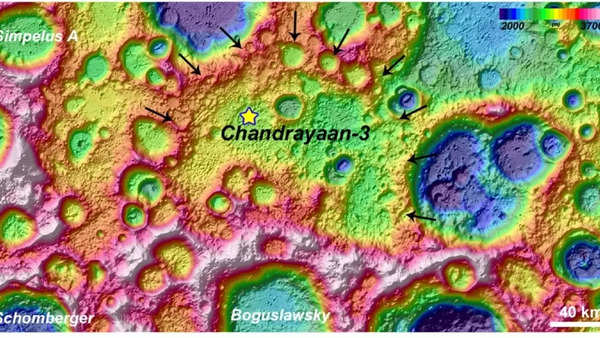Chandrayaan-3 landed in one in all Moon’s oldest craters, Isro scientists declare discovery
BENGALURU: Scientists from the Bodily Analysis Laboratory (PRL) and others from ISRO have proven that India’s Chandrayaan-3 landed inside a buried influence crater, which is round 160 km in dimension, round 4.4 km deep, and more likely to be older than the South Pole Atkin (SPA) basin.
“This buried crater is likely one of the oldest craters on the Moon, and the Chandrayaan-3 lander (Vikram) and rover (Pragyan) landed and roved inside this buried crater, which is internet hosting the SPA basin ejecta materials and a number of the most deeply excavated supplies on the Moon,” ISRO mentioned Tuesday.
Ejecta means materials that’s compelled or thrown out, particularly on account of volcanic eruption, meteoritic influence, or stellar explosion.
Their findings are primarily based on evaluation of photos obtained by navigation cameras (navcams) on Chandrayaan-3 rover (Pragyan) and Chandrayaan-2 orbiter’s Optical Excessive Decision Digicam (OHRC). The work, authored by S Vijayan, KB Kimi, Anil Chavan, R Aditi, U Thahira, V Rama Subramanian, Rishitosh Okay Sinha, Santosh Vadawale, M Shanmugam, NPS Mithun, Arpit R Patel, S Amit Basu, KV Iyer, Okay Suresh, Ajay Prashar, G Rima and Anil Bhardwaj, has been printed as a research within the peer-reviewed journal Icarus.
“The Chandrayaan-3 mission with the lander (Vikram) and Pragyan landed within the excessive latitude highland area close to the south pole of Moon. The touchdown web site is positioned round 350 km from the South Pole-Aitken basin rim, an historical and the most important influence basin within the Photo voltaic System,” ISRO mentioned Tuesday.
It added that this touchdown web site has undergone the advanced emplacement sequence of SPA basin ejecta adopted by the close by and distant influence basins and sophisticated crater ejecta supplies.
“We discovered that the SPA basin is the foremost contributor, which deposited practically round 1400 m of ejecta supplies, and 11 different basins deposited round 580 m of ejecta. The opposite advanced craters contributed as much as round 90 m of ejecta. In the meantime, secondary craters of some kilometres in diameter positioned adjoining to the Vikram lander contributed to round 0.5 m ejecta, that are essential goal supplies for the Pragyan’s in-situ evaluation,” ISRO mentioned.
Photos from Pragyan’s navcams and the OHRC gave the primary clue concerning the linear, distal ejecta rays or groove-like buildings presumably fashioned because of the distant impacts deposited on the Chandrayaan-3 touchdown web site, the scientists mentioned.

“The regional exploration across the Chandrayaan-3 touchdown web site revealed a close to semi-circular like construction, extremely degraded in nature. This construction encompassed the Statio Shiv Shakti (yellow star). Additional detailed geomorphological and topographical evaluation revealed that the construction is a closely degraded crater construction or a buried influence crater with a diameter of round 160 km,” ISRO mentioned.



